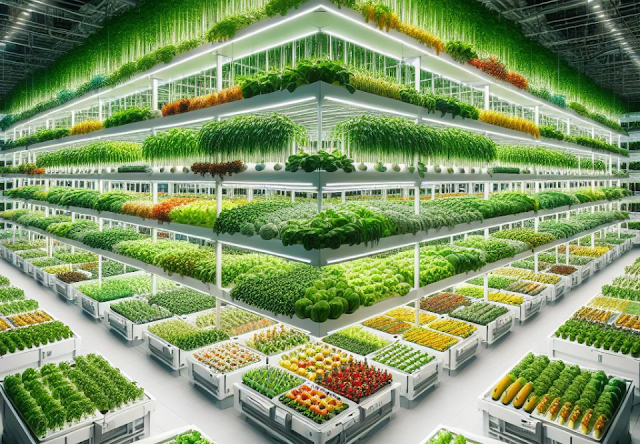
In the heart of bustling cities, where space is at a premium and the demand for fresh produce is ever-growing, a silent revolution is taking root: vertical farming. This innovative approach to agriculture is reshaping the way we think about food production, sustainability, and urban landscapes. Vertical farming is the practice of cultivating crops in vertically stacked layers or vertically inclined surfaces. These farms can be indoors, in greenhouses, or even on the sides of buildings. Instead of sprawling fields, vertical farms utilize height to maximize growing space. According to Statista, the global value of indoor farming reached 38 billion U.S. dollars in 2022 and is expected to grow to over 55 billion U.S. dollars by 2032.1 Rapid urbanization has led to shrinking agricultural land. As cities expand, arable land disappears, leaving us with a paradox: How do we feed a growing population when our cities are swallowing up farmland? Vertical farming steps in as a viable solution. By growing crops upwards rather than outwards, it optimizes space utilization. Imagine entire skyscrapers transformed into lush green farms, producing fresh vegetables, herbs, and fruits year-round.
Vertical farms rely on artificial lighting, which can be energy-intensive. Businesses must invest in energy-efficient LED systems and explore renewable energy sources. Setting up a vertical farm requires capital. However, businesses can collaborate with urban developers, governments, and investors to create shared spaces. Vertical farming demands expertise in horticulture, engineering, and technology. Businesses can partner with educational institutions to train a skilled workforce. While the concept is gaining traction, consumers may not yet be familiar with or willing to pay a premium for vertically-farmed produce. Building brand awareness and educating consumers is important. Not all crops are suited for vertical farming due to space limitations and light requirements. Business owners need to carefully choose crops that are profitable and meet consumer demand.
AeroFarms is a leading innovator in vertical farming technology. They utilize aeroponic systems and LED lighting to cultivate leafy greens in vertically stacked layers within controlled indoor environments. Traditional agriculture faces numerous challenges, including limited land availability, dwindling water resources, and increasing demand for fresh produce, particularly in urban areas. AeroFarms' vertical design maximizes space utilization, making it ideal for urban settings. Their aeroponic systems deliver a precise mist containing water and nutrients directly to the plant roots, eliminating the need for large volumes of water used in traditional farming. Controlled environments minimize exposure to pests and diseases, reducing the need for chemical pesticides. Precise control over light, temperature, and nutrients allows for optimized plant growth, leading to higher yields per square foot. Unaffected by weather fluctuations, AeroFarms can produce fresh produce consistently throughout the year. AeroFarms leverages a suite of advanced technologies to achieve its sustainable and productive growing model. Their proprietary aeroponic system delivers a customized mist of water and nutrients directly to plant roots, maximizing efficiency and minimizing waste. Real-time data from sensors is used to monitor and optimize growing conditions, ensuring consistent quality and optimal yields. Specially designed LED lights provide the precise light spectrum needed for each plant variety, promoting growth and maximizing resource utilization. AeroFarms stands as a prime example of how technology can revolutionize agriculture and contribute to a more sustainable future. Their innovative vertical farming solutions offer a compelling case for businesses seeking to operate more sustainably and efficiently while meeting the growing demand for fresh, local produce. 2
Vertical farms operate independently of seasons and weather conditions. With controlled environments, crops receive consistent light, temperature, and humidity. No more waiting for spring or fearing frost – harvests happen 365 days a year. Traditional agriculture consumes vast amounts of water. Vertical farms use hydroponics or aeroponics, drastically reducing water usage. The closed-loop systems recirculate water, minimizing waste. In a water-scarce world, this is a game-changer. Produce travels thousands of miles from rural farms to city markets. Vertical farms can be located within urban centers, cutting down transportation distances. Fresher produce, fewer emissions – it’s a win-win. Controlled environments mean fewer pests and diseases. Vertical farms can avoid chemical pesticides altogether. Plus, they’re ideal for experimenting with non-GMO varieties. Imagine a high-rise building with floors dedicated to different crops – tomatoes on one level, lettuce on another, strawberries higher up. Vertical farming allows for biodiversity within a single structure. Aeroponics, aquaponics, and hydroponics are the main technologies involved in vertical farming. Aquaponics is the technology with the highest forecast growth, at over ten billion value growth between 2022 and 2032. 3
Market leaders are creating a network of vertical farms across major cities. These farms not only supply fresh produce but also serve as community hubs – educational centers, rooftop cafes, and green oases. They are synonymous with sustainable living, inspiring others to follow suit. Vertical farming isn’t just about food; it’s about transforming concrete jungles into thriving ecosystems. Market leaders are using less land, minimizing water consumption, and lowering reliance on chemical fertilizers contributing significantly to a greener future. They have precise control over growing conditions optimizing water, light, and nutrient usage, minimizing waste. In controlled environments it allows for consistent crop yields regardless of external factors, promoting food security and reducing reliance on long-distance transportation. The future of vertical farming is bright. As these technologies continue to develop and become more affordable, we can expect even greater sustainability benefits and a more secure and efficient food production system for our growing urban populations.